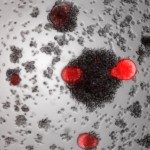Lien vers Pubmed [PMID] – 25737587
Sci Signal 2015 Mar;8(366):ra25
Although plasmacytoid dendritic cells (pDCs) represent a rare immune cell type, they are the most important source of type I interferons (IFNs) upon viral infection. Phagocytosed RNA viruses and RNA virus-infected cells are detected by pDCs with the endosomal pattern recognition receptor (PRR) toll-like receptor 7 (TLR7). We showed that replication of the yellow fever live vaccine YF-17D in human pDCs and pDC-like cell lines stimulated type I IFN production through RIG-I (retinoic acid-inducible gene I), a member of the RIG-I-like receptor (RLR) family of cytosolic PRRs. Thus, human pDCs sense replicative viral RNA. In contrast, direct contact between pDCs and YF-17D-infected cells stimulated a TLR7-dependent, viral replication-independent production of type I IFN. We also showed that the RLR pathway was dampened by the activities of interleukin-1 receptor-associated kinases 1 and 4 (IRAK1 and IRAK4), which are downstream effectors of the TLR7 pathway, suggesting that both kinases play opposing roles downstream of specific PRRs. Together, these data suggest that a virus can stimulate either TLR or RLR signaling in the same cell, depending on how its nucleic acid content is delivered.


